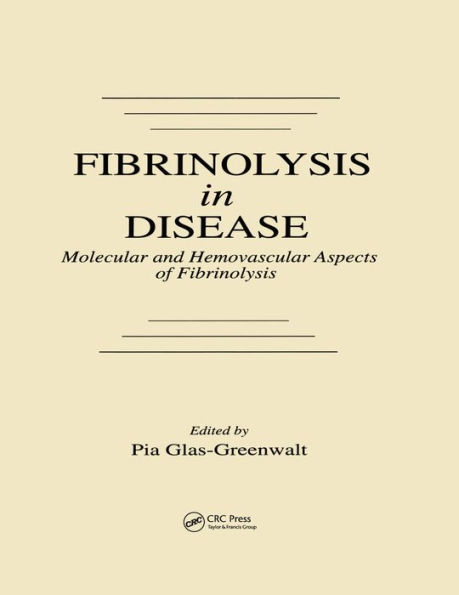Table of Contents
I. MOLECULAR BIOLOGY OF THE CHIEF REGULATORS OF THE FIBRINOLYTIC/PROTEOLYTIC ENZYME SYSTEMS, Chapter 1. Gene Expression and Function of Tissue Plasminogen Activator, Chapter 2. Structure and Function of the Urokinase-Type Plasminogen Activator Gene, Chapter 3. Gene Expression and Function of Plasminogen Activator Inhibitor-1, Chapter 4. Gene Expression and Function of the Cellular Receptor for u-PA (u-PAR), II. THE ROLE OF THE PLAMINOGEN ACTIVATION SYSTEM IN THE MAINTENANCE OF VASCULAR INTEGRITY, A. General Aspects, Chapter 5. Hepatic Regulation of Fibrinolysis in Normal and Diseased States, Chapter 6. Normal and Abnormal Endothelial Release of t-P A, Chapter 7. Platelets and Fibrinolysis/Thrombolysis, Chapter 8. Lipoprotein(a) and Fibrinolysis, B. Fibrinolytic Abnormalities in Various Disease States, Chapter 9. Role of Plasminogen Activator Inhibitor Type 1 (PAI-1) in the Clinical Setting, Including Deep Vein Throm bosis, Chapter 10. Fibrinolysis Factors as Predictors of a Coronary E vent, Chapter 11. The Acute-Phase Reaction of the Fibrinolytic System in Acute Myocardial Infarction and Unstable Angina, Chapter 12. High PAI Activity as an Indicator of Disease Activity in Rest Angina, Chapter 13. High PAI-1 Levels as Marker of Rethrombosis after Successful Coronary Balloon Angioplasty, Chapter 14. Impaired Fibrinolysis in Cigarette Smokers, Chapter 15. Fibrinolysis and Inflammation, Chapter 16. The Fibrinolytic Response to Intravenous Endotoxin Administration, Chapter 17. Prognostic Markers in Septic Shock, Chapter 18. Mechanisms Leading to the Activation of the Fibrinolytic System in Septicemia, Chapter 19. Observations on the Fibrinolytic Response in Two Models of the Baboon in Response to E. coli: Consumptive and Thrombotic Coagulopathies, Chapter 20. Effects of TNF-cc on Endothelial Control of Hemostasis, Chapter 21. Hypercoagulable State in Trauma Patients, Chapter 22. Hypofibrinolysis and Hyperinsulinemia, Chapter 23. Predisposition to Thrombotic Complications in Diabetes Mellitus, Chapter 24. Fibrinolysis and Diabetes Mellitus, Chapter 25. Fibrinolysis and Obesity, Chapter 26. PAI-1 Activity and Serum Lipid Levels, Chapter 27. Hyperfibrinolysis in Liver Cirrhosis, Chapter 28. Hyperfibrinolysis in Liver Transplantation, Chapter 29. Role of Mediators Released by Leukocytes During Liver Transplantation as Possible Contributing Factor for Hyperfibrinolysis and DIC, Chapter 30. Type 1 and Type 2 Plasminogen Activator Inhibitors in Preeclampsia, Chapter 31. Effects of Low-Dose Oral Contraceptives on Fibrinolysis in Teenagers, Chapter 32. Effects of Low-Dose Ethinylestradiol Oral Contraceptives Differing in Progesteron Compound on Coagulation- and Fibrinolytic-Risk Variables for Venous and Arterial Thromboembolic Diseases, Chapter 33. Fibrinolytic Abnormatities and Antiphospholipid Antibodies, Chapter 34. Blood Coagulation and Fibrinolysis in TTP and HUS, Chapter 35. Altered Regulation of Fibrinolysis in Scleroderma and Potential for Thrombolytic Therapy, Chapter 36. Dysregulation of the PA-PAI System in Pulmonary Disease (ARDS and Fibrosis), Chapter 37. Plasminogen Activator Enzymes and Inhibitors in Epithelial Biology and Pathology, Chapter 38. Fibrinolytic Defects in the Cutaneous Vasculitis Atrophie Blanche, INDEX



